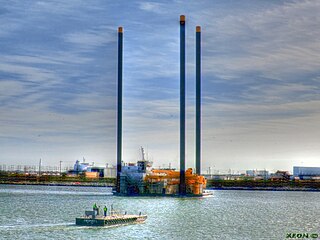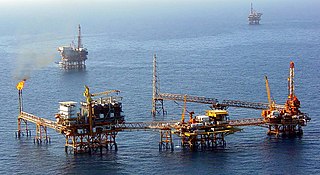
Naval architecture, or naval engineering, is an engineering discipline incorporating elements of mechanical, electrical, electronic, software and safety engineering as applied to the engineering design process, shipbuilding, maintenance, and operation of marine vessels and structures. Naval architecture involves basic and applied research, design, development, design evaluation (classification) and calculations during all stages of the life of a marine vehicle. Preliminary design of the vessel, its detailed design, construction, trials, operation and maintenance, launching and dry-docking are the main activities involved. Ship design calculations are also required for ships being modified. Naval architecture also involves formulation of safety regulations and damage-control rules and the approval and certification of ship designs to meet statutory and non-statutory requirements.

Offshore construction is the installation of structures and facilities in a marine environment, usually for the production and transmission of electricity, oil, gas and other resources. It is also called maritime engineering.

A power station, also referred to as a power plant and sometimes generating station or generating plant, is an industrial facility for the generation of electric power. Power stations are generally connected to an electrical grid.

A diving support vessel is a ship that is used as a floating base for professional diving projects. Basic requirements are the ability to keep station accurately and reliably throughout a diving operation, often in close proximity to drilling or production platforms, for positioning to degrade slowly enough in deteriorating conditions to recover divers without excessive risk, and to carry the necessary support equipment for the mode of diving to be used.

A tension-leg platform (TLP) or extended tension leg platform (ETLP) is a vertically moored floating structure normally used for the offshore production of oil or gas, and is particularly suited for water depths greater than 300 metres and less than 1500 metres. Use of tension-leg platforms has also been proposed for offshore wind turbines.

Marine engineering is the engineering of boats, ships, submarines, and any other marine vessel. Here it is also taken to include the engineering of other ocean systems and structures – referred to in certain academic and professional circles as "ocean engineering".

A ballast tank is a compartment within a boat, ship or other floating structure that holds water, which is used as ballast to provide hydrostatic stability for a vessel, to reduce or control buoyancy, as in a submarine, to correct trim or list, to provide a more even load distribution along the hull to reduce structural hogging or sagging stresses, or to increase draft, as in a semi-submersible vessel or platform, or a SWATH, to improve seakeeping. Using water in a tank provides easier weight adjustment than the stone or iron ballast used in older vessels, and makes it easy for the crew to reduce a vessel's draft when it enters shallower water, by temporarily pumping out ballast. Airships use ballast tanks mainly to control buoyancy and correct trim.

A liftboat is a self-propelled, self-elevating vessel used in support of various offshore mineral exploration and production or offshore construction activities. A liftboat has a relatively large open deck to accommodate equipment and supplies, and the capability of raising its hull clear of the water on its own legs so as to provide a stable platform from which maintenance and construction work may be conducted.

Very large floating structures (VLFSs) or very large floating platforms (VLFPs) are artificial islands, which may be constructed to create floating airports, bridges, breakwaters, piers and docks, storage facilities, wind and solar power plants, for military purposes, to create industrial space, emergency bases, entertainment facilities, recreation parks, mobile offshore structures and even for habitation. Currently, several different concepts have been proposed for building floating cities or huge living complexes. Some units have been constructed and are presently in operation.
Subsea technology involves fully submerged ocean equipment, operations, or applications, especially when some distance offshore, in deep ocean waters, or on the seabed. The term subsea is frequently used in connection with oceanography, marine or ocean engineering, ocean exploration, remotely operated vehicle (ROVs) autonomous underwater vehicles (AUVs), submarine communications or power cables, seafloor mineral mining, oil and gas, and offshore wind power.

A jackup rig or a self-elevating unit is a type of mobile platform that consists of a buoyant hull fitted with a number of movable legs, capable of raising its hull over the surface of the sea. The buoyant hull enables transportation of the unit and all attached machinery to a desired location. Once on location the hull is raised to the required elevation above the sea surface supported by the sea bed. The legs of such units may be designed to penetrate the sea bed, may be fitted with enlarged sections or footings, or may be attached to a bottom mat. Generally jackup rigs are not self-propelled and rely on tugs or heavy lift ships for transportation.

A floating wind turbine is an offshore wind turbine mounted on a floating structure that allows the turbine to generate electricity in water depths where fixed-foundation turbines are not feasible. Floating wind farms have the potential to significantly increase the sea area available for offshore wind farms, especially in countries with limited shallow waters, such as Spain, Portugal, Japan, France and the United States' West Coast. Locating wind farms further offshore can also reduce visual pollution, provide better accommodation for fishing and shipping lanes, and reach stronger and more consistent winds.
Offshore concrete structures, or concrete offshore structures, are structures built from reinforced concrete for use in the offshore marine environment. They serve the same purpose as their steel counterparts in oil and gas production and storage. The first concrete oil platform was installed in the North Sea in the Ekofisk oil field in 1973 by Phillips Petroleum, and they have become a significant part of the marine construction industry. Since then at least 47 major concrete offshore structures have been built.

Offshore wind power or offshore wind energy is the generation of electricity through wind farms in bodies of water, usually at sea. There are higher wind speeds offshore than on land, so offshore farms generate more electricity per amount of capacity installed. Offshore wind farms are also less controversial than those on land, as they have less impact on people and the landscape.

The Port of Lowestoft is a harbour and commercial port in Lowestoft in the English county of Suffolk owned by Associated British Ports. It is the most easterly harbour in the United Kingdom and has direct sea access to the North Sea. The harbour is made up of two sections divided by a bascule bridge. The inner harbour is formed by Lake Lothing whilst the outer harbour is constructed from breakwaters. Lowestoft handles around 30,000 tonnes of cargo per year.

Suction caissons are a form of fixed platform anchor in the form of an open bottomed tube embedded in the sediment and sealed at the top while in use so that lifting forces generate a pressure differential that holds the caisson down. They have a number of advantages over conventional offshore foundations, mainly being quicker to install than deep foundation piles and being easier to remove during decommissioning. Suction caissons are now used extensively worldwide for anchoring large offshore installations, like oil platforms, offshore drillings and accommodation platforms to the seafloor at great depths. In recent years, suction caissons have also seen usage for offshore wind turbines in shallower waters.

Commercial offshore diving, sometimes shortened to just offshore diving, generally refers to the branch of commercial diving, with divers working in support of the exploration and production sector of the oil and gas industry in places such as the Gulf of Mexico in the United States, the North Sea in the United Kingdom and Norway, and along the coast of Brazil. The work in this area of the industry includes maintenance of oil platforms and the building of underwater structures. In this context "offshore" implies that the diving work is done outside of national boundaries. Technically it also refers to any diving done in the international offshore waters outside of the territorial waters of a state, where national legislation does not apply. Most commercial offshore diving is in the Exclusive Economic Zone of a state, and much of it is outside the territorial waters. Offshore diving beyond the EEZ does also occur, and is often for scientific purposes.
The following outline is provided as an overview of and topical guide to wind energy:

Offshore geotechnical engineering is a sub-field of geotechnical engineering. It is concerned with foundation design, construction, maintenance and decommissioning for human-made structures in the sea. Oil platforms, artificial islands and submarine pipelines are examples of such structures. The seabed has to be able to withstand the weight of these structures and the applied loads. Geohazards must also be taken into account. The need for offshore developments stems from a gradual depletion of hydrocarbon reserves onshore or near the coastlines, as new fields are being developed at greater distances offshore and in deeper water, with a corresponding adaptation of the offshore site investigations. Today, there are more than 7,000 offshore platforms operating at a water depth up to and exceeding 2000 m. A typical field development extends over tens of square kilometers, and may comprise several fixed structures, infield flowlines with an export pipeline either to the shoreline or connected to a regional trunkline.
Marine construction is the process of building structures in or adjacent to large bodies of water, usually the sea. These structures can be built for a variety of purposes, including transportation, energy production, and recreation. Marine construction can involve the use of a variety of building materials, predominantly steel and concrete. Some examples of marine structures include ships, offshore platforms, moorings, pipelines, cables, wharves, bridges, tunnels, breakwaters and docks. Marine construction may require diving work, but professional diving is expensive and dangerous, and may involve relatively high risk, and the types of tools and equipment that can both function underwater and be safely used by divers are limited. Remotely operated underwater vehicles (ROVs) and other types of submersible equipment are a lower risk alternative, but they are also expensive and limited in applications, so when reasonably practicable, most underwater construction involves either removing the water from the building site by dewatering behind a cofferdam or inside a caisson, or prefabrication of structural units off-site with mainly assembly and installation done on-site.


















